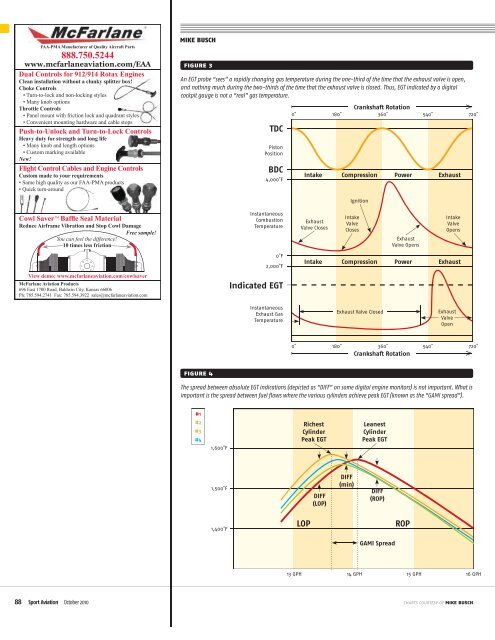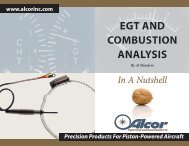EGT Myths Debunked
EGT Myths Debunked
EGT Myths Debunked
Create successful ePaper yourself
Turn your PDF publications into a flip-book with our unique Google optimized e-Paper software.
FAA-PMA Manufacturer of Quality Aircraft Parts<br />
888.750.5244<br />
www.mcfarlaneaviation.com/EAA<br />
Dual Controls for 912/914 Rotax Engines<br />
Clean installation without a clunky splitter box!<br />
Choke Controls<br />
Turn-to-lock and non-locking styles<br />
Many knob options<br />
Throttle Controls<br />
Panel mount with friction lock and quadrant styles<br />
Convenient mounting hardware and cable stops<br />
Push-to-Unlock and Turn-to-Lock Controls<br />
Heavy duty for strength and long life<br />
Many knob and length options<br />
Custom marking available<br />
New!<br />
Flight Control Cables and Engine Controls<br />
Custom made to your requirements<br />
Same high quality as our FAA-PMA products<br />
Quick turn-around<br />
Cowl Saver Baf� e Seal Material<br />
Reduce Airframe Vibration and Stop Cowl Damage<br />
Free sample!<br />
You can feel the difference!<br />
10 times less friction<br />
View demo: www.mcfarlaneaviation.com/cowlsaver<br />
McFarlane Aviation Products<br />
696 East 1700 Road, Baldwin City, Kansas 66006<br />
Ph: 785.594.2741 Fax: 785.594.3922 sales@mcfarlaneaviation.com<br />
88 Sport Aviation October 2010<br />
MIKE BUSCH<br />
FIGURE 3<br />
An <strong>EGT</strong> probe “sees” a rapidly changing gas temperature during the one-third of the time that the exhaust valve is open,<br />
and nothing much during the two-thirds of the time that the exhaust valve is closed. Thus, <strong>EGT</strong> indicated by a digital<br />
cockpit gauge is not a “real” gas temperature.<br />
FIGURE 4<br />
#1<br />
#2<br />
#3<br />
#4<br />
1,600˚F<br />
1,500˚F<br />
1,400˚F<br />
TDC<br />
Piston<br />
Position<br />
BDC<br />
4,000˚F<br />
Instantaneous<br />
Combustion<br />
Temperature<br />
0˚F<br />
2,000˚F<br />
Indicated <strong>EGT</strong><br />
Instantaneous<br />
Exhaust Gas<br />
Temperature<br />
0˚ 180˚<br />
Crankshaft Rotation<br />
360˚ 540˚ 720˚<br />
Intake<br />
Exhaust<br />
Valve Closes<br />
Intake<br />
Compression<br />
Ignition<br />
Intake<br />
Valve<br />
Closes<br />
Compression<br />
Power<br />
Exhaust<br />
Valve Opens<br />
Power<br />
Exhaust<br />
Intake<br />
Valve<br />
Opens<br />
Exhaust<br />
Exhaust Valve Closed Exhaust<br />
Valve<br />
Open<br />
0˚ 180˚ 360˚<br />
Crankshaft Rotation<br />
540˚ 720˚<br />
The spread between absolute <strong>EGT</strong> indications (depicted as “DIFF” on some digital engine monitors) is not important. What is<br />
important is the spread between fuel fl ows where the various cylinders achieve peak <strong>EGT</strong> (known as the “GAMI spread”).<br />
Richest<br />
Cylinder<br />
Peak <strong>EGT</strong><br />
DIFF<br />
(LOP)<br />
DIFF<br />
(min)<br />
Leanest<br />
Cylinder<br />
Peak <strong>EGT</strong><br />
DIFF<br />
(ROP)<br />
LOP ROP<br />
GAMI Spread<br />
13 GPH 14 GPH 15 GPH 16 GPH<br />
CHARTS COURTESY OF MIKE BUSCH






